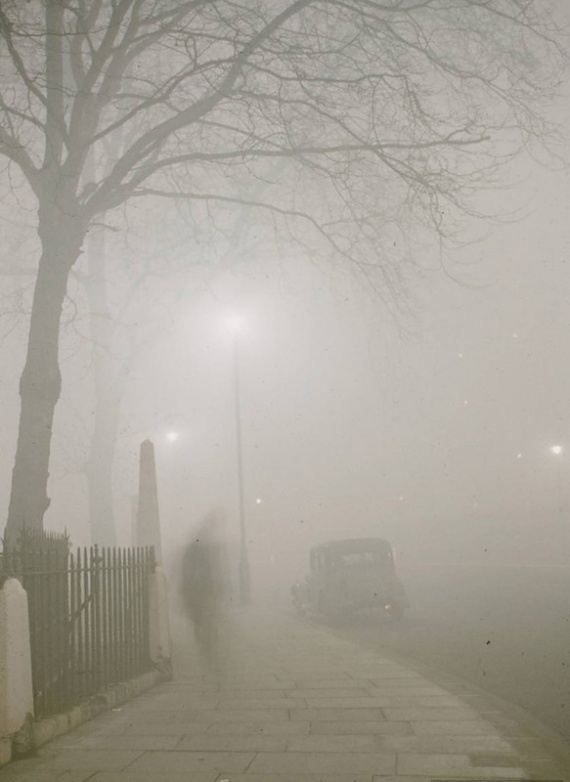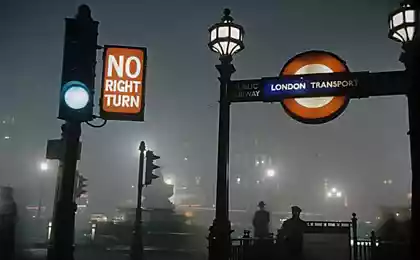1114
England in the dark (9 photos)
It has been 60 years since the great catastrophe occurred in England.
December 5, 1952 the great London smog enveloped and lifted only after 4 days.
Injured more than 100 thousand people, 12 thousand were killed.
American magazine photographer managed to capture the atmosphere.

At the beginning of December 1952 cold fog descended on London. The cold citizens was used for heating coal in a larger amount than usual. At about the same time, the process of replacing the municipal electric (trams), buses with diesel engines. Locked heavier layer of cold air, the products of combustion in the air in a few days reached the extreme concentration.

The fog was so thick that prevented the movement of vehicles. Concerts were canceled, terminated a demonstration of movies as easily able to penetrate inside the premises. Spectators sometimes simply did not see the stage or the screen due to the dense veil. By Friday evening, the fog thickened so that the limit of visibility reduced to five meters. Some townspeople came out of the house, could not find his way back; bewildered impenetrable smog, they could go, just holding on to the walls of nearby houses.

Many people wore special masks of gauze and some covered their faces with scarves or handkerchiefs usual, but neither one nor the other did not help - could not breathe:

At first, the reaction of the citizens was calm, since the London fog is not uncommon. In the following weeks, however, the statistics compiled by the health services of the city, revealed the deadly nature of the disaster - the number of deaths among infants, the elderly and those suffering from respiratory diseases has reached four thousand people. More about eight thousand people died in the following weeks and months.

Unpleasant impenetrable fog was one of the distinguishing features of London for centuries. About the mists of the British capital, he wrote Dickens, who called it "part of the personality of London," wrote Conan Doyle's stories of Sherlock Holmes, and Robert Stevenson in "Strange Case of Dr Jekyll and Mr Hyde". Mist - it is the same heritage of England, as the architecture of old London and the royal family.

The word "smog" (smoke and poisonous mixture of exhaust gases with fog) appeared in only forty years before the events described, and was introduced into circulation in 1905 by Dr. Henry de Vaux.

On Saturday, December 6, 1952 Sadler's Wells Theatre in "La Traviata" was interrupted in the middle due to the fact that the audience suddenly began to cough. Thick acrid fog slowly filled the room and see the scene from the gallery has become almost impossible.

Hospitals were filled with people with respiratory problems and mortality in the city gradually began to grow. At first no one noticed, but a few days later it turned out that the undertakers finished coffins, while florists - mourning wreaths. Ambulances were unable to reach the sick - the entire city stood in one big traffic jam can not budge. People died from suffocation.

The shock caused by this cruel lesson that forced people to change their attitude to air pollution. The disaster has clearly demonstrated the people of the world, that this problem is a direct threat to people's lives. The adoption of new environmental standards, aimed at limiting the use of dirty fuels in industry and the prohibition sazhesoderzhaschih exhaust. Among the measures taken - enactment "Clean Air" (edition from 1956 and 1968) and similar laws of the city of London (1954).
Source: visualhistory.livejournal.com
December 5, 1952 the great London smog enveloped and lifted only after 4 days.
Injured more than 100 thousand people, 12 thousand were killed.
American magazine photographer managed to capture the atmosphere.

At the beginning of December 1952 cold fog descended on London. The cold citizens was used for heating coal in a larger amount than usual. At about the same time, the process of replacing the municipal electric (trams), buses with diesel engines. Locked heavier layer of cold air, the products of combustion in the air in a few days reached the extreme concentration.

The fog was so thick that prevented the movement of vehicles. Concerts were canceled, terminated a demonstration of movies as easily able to penetrate inside the premises. Spectators sometimes simply did not see the stage or the screen due to the dense veil. By Friday evening, the fog thickened so that the limit of visibility reduced to five meters. Some townspeople came out of the house, could not find his way back; bewildered impenetrable smog, they could go, just holding on to the walls of nearby houses.

Many people wore special masks of gauze and some covered their faces with scarves or handkerchiefs usual, but neither one nor the other did not help - could not breathe:

At first, the reaction of the citizens was calm, since the London fog is not uncommon. In the following weeks, however, the statistics compiled by the health services of the city, revealed the deadly nature of the disaster - the number of deaths among infants, the elderly and those suffering from respiratory diseases has reached four thousand people. More about eight thousand people died in the following weeks and months.

Unpleasant impenetrable fog was one of the distinguishing features of London for centuries. About the mists of the British capital, he wrote Dickens, who called it "part of the personality of London," wrote Conan Doyle's stories of Sherlock Holmes, and Robert Stevenson in "Strange Case of Dr Jekyll and Mr Hyde". Mist - it is the same heritage of England, as the architecture of old London and the royal family.

The word "smog" (smoke and poisonous mixture of exhaust gases with fog) appeared in only forty years before the events described, and was introduced into circulation in 1905 by Dr. Henry de Vaux.

On Saturday, December 6, 1952 Sadler's Wells Theatre in "La Traviata" was interrupted in the middle due to the fact that the audience suddenly began to cough. Thick acrid fog slowly filled the room and see the scene from the gallery has become almost impossible.

Hospitals were filled with people with respiratory problems and mortality in the city gradually began to grow. At first no one noticed, but a few days later it turned out that the undertakers finished coffins, while florists - mourning wreaths. Ambulances were unable to reach the sick - the entire city stood in one big traffic jam can not budge. People died from suffocation.

The shock caused by this cruel lesson that forced people to change their attitude to air pollution. The disaster has clearly demonstrated the people of the world, that this problem is a direct threat to people's lives. The adoption of new environmental standards, aimed at limiting the use of dirty fuels in industry and the prohibition sazhesoderzhaschih exhaust. Among the measures taken - enactment "Clean Air" (edition from 1956 and 1968) and similar laws of the city of London (1954).
Source: visualhistory.livejournal.com























